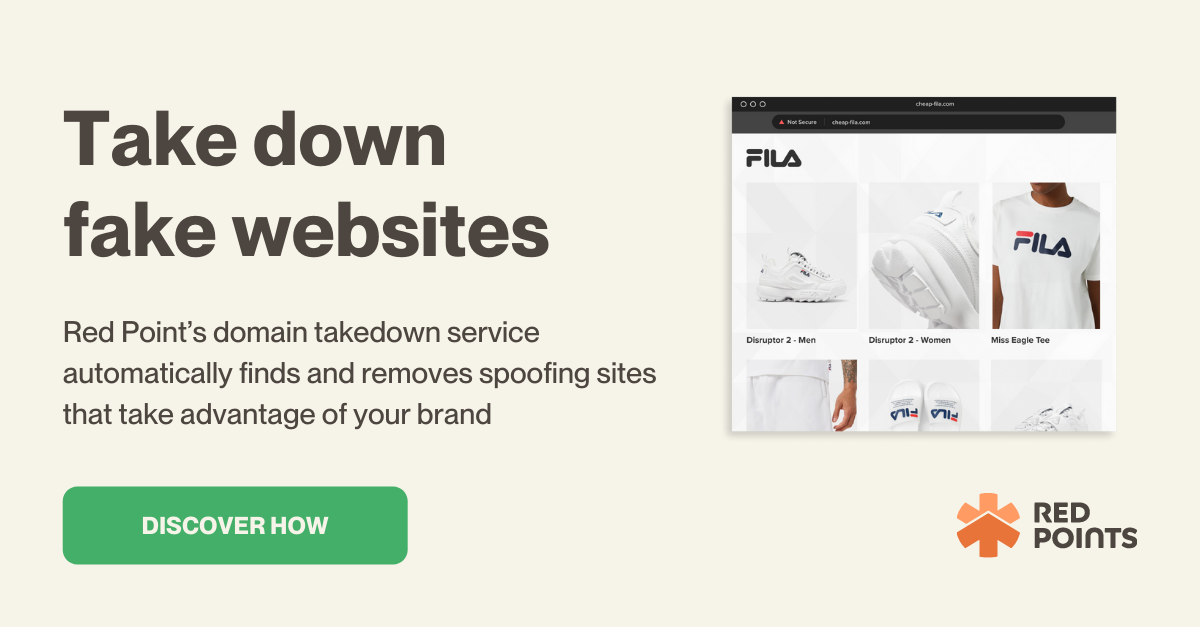Domain names are the key to a business’s web presence and as such you want to make sure not to lose control over it. Through your domain, you can attract customers online and add credibility to your business. A good way to think of your domain is to view it as your digital online property. Like physical properties, domain names need maintenance and protection to keep their value and shield them from risk factors.
Domain spoofing is a frequently executed threat through which cyber criminals create fake web addresses that pretend to be legitimate but in fact lead users to a fraudulent site to steal sensitive information or sell fake products. Domain owners, therefore, need a protection scheme that safeguards them from those attacks. Domain spoofing protection ensures that scammers don’t imitate your domain name to damage your brand reputation, steal your sales and infringe your intellectual property.
In this article, we introduce domain spoofing protection and provide all the necessary information you need to protect your brand from domain spoofing.
Summary:
- What domain spoofing protection is and why brand owners should protect their domains
- Domain spoofing schemes and their impact on brands
- What to look out for when choosing domain spoofing protection
- Learn how domain spoofing protection enables brands to control and enforce their domain portfolios on a broad scale

What is domain spoofing protection?
Domain spoofing protection offers businesses a way to monitor and safeguard their domain from being spoofed. Brands often work with more than one domain which requires a protection plan that is capable of safeguarding entire domain portfolios. As this is difficult to do manually, domain spoofing protection is usually exerted by a software solution. Overall, a domain spoofing protection solution enables brands to control and enforce their domain portfolios on a broad scale.
Also known as domain monitoring software, a good domain monitoring service should include a variety of options to choose from, so clients can build their own service based on their needs regarding detection, enforcement, and/or assessment. This is important as brands can find themselves in a variety of risk scenarios that require individual solutions.
Why do people spoof your domain?
Cybersquatting cases have increased 11% globally in recent years. In most cases, scammers register variations of your domains to either steal sensitive information from users or sell fake products to them:
Mimic your official website and mislead users
One of the most common spoofing techniques is the creation of look-a-like websites to mislead users. Impersonators execute this form of identity theft by copying the appearance of a brand’s website including the layout of the site, product listings, and trademarks of the brand. Those mimicked websites usually have very small differences from the real websites and are hard to detect by visitors.
Infringers, therefore, register domain names that haven’t yet been registered by the legitimate brand or register slight variations or misspellings of a genuine domain. This technique, also known as typosquatting, is intended to lure users that mistype web addresses. The combination of almost identical domain names and website designs appears to make it easy for scammers to make customers believe that they are on the correct website.
Impersonators not only copy websites of legitimate brands but also their social media accounts by using the same account names, photos, hashtags, descriptions, etc. as the official accounts. In any case, spoofed websites and social media accounts are designed to look identical to the genuine web page or account and lure unknown users into taking an action.
Overall, domain spoofing is typically used by cybercriminals for phishing or scamming purposes as we discuss further below.
Steal users’ personal and financial information
Phishing is a form of social engineering attack and is typically executed to steal sensitive information. This can be personal data like phone numbers, physical and virtual addresses, medical data, or login credentials. Scammers are also especially keen to steal financial information like credit card, bank account, and social security numbers.
Through domain spoofing, impersonators pretend to be a trusted entity like a well-known brand and trick a victim into clicking on a malicious link or asking users to reveal sensitive data. Clicking on a fraudulent link can lead to the installation of malware on the device of the user or spying on personal data without the detection of the user. Victims might also be asked to actively reveal sensitive information when imposters use a domain in an email sent to customers or employees of a company pretending to be the legitimate sender or entity.
Sell counterfeit copies of your products
Apart from stealing sensitive data, selling counterfeit products is another way domain spoofers can maliciously profit from. Counterfeit-selling websites use the same mimic approach outlined above to make customers believe that they arrived at the original website or online shop of a brand. In addition to copying the brands’ website design, trademarks, and product listings, scammers also imitate the actual products of a brand and try to sell them to unknowing customers.
Spoofers also mimic social media accounts to sell counterfeits of your product. It often takes a few days until fake social media accounts are detected and impersonators take advantage of that by launching aggressive advertising campaigns that target the brand’s consumers. After clicking on a link, customers are redirected to a fraudulent website outside the social network where the transaction takes place.
Every mistaken customer that purchases counterfeit products of your brand means a direct sales loss. The problem gets even more complicated as many retailers that sell your products don’t have the knowledge or resources to detect fake products and bring them into circulation.
What is the impact of domain spoofing?
Revenue losses can be devastating for businesses but they are not the only threat that occurs from domain spoofing:
Profit loss
If customers notice that they arrived on a fake website of yours, it damages their experience and will prevent people from coming back to your site. The fewer people come to your site the less likely you are going to promote your business via your website. Like we mentioned above, a fall in sales from your website is a direct repercussion of domain spoofing as infringing domains divert business to fraudulent websites.
The global economic damage of counterfeits is immense and has grown to a parallel economy that profits from the losses of hard-working honest companies. As of 2020, annual sales losses from counterfeiting are estimated at €26.3 billion globally in the clothing industry alone.
Loss of search visibility
Domain spoofing also negatively affects your companies visibility online. Domain infringers use similar promotion techniques as legitimate businesses which means that they can divert traffic away from your official site due to infringing domains. Marketing strategies such as false advertising, black hat SEO tactics, and spam could drive even more traffic to illegitimate product placements.
Damaged reputation
Your brand reputation is one of the most valuable assets of your company. Customers are often unaware that the product they bought is a counterfeit. When the quality of the product turns out to be bad, which is usually the case with fake products, customers blame the original company. They often write a bad review online which in turn damages brand reputation even more.
Counterfeit products can also put consumers’ health and safety at risk. Especially knock-off makeup and skincare products can be dangerous for consumers. The packaging and product appearance might look identical to the authentic brand, but when applied, they can cause skin infections and other health problems. You can imagine that such incidents will cause serious reputation damages for brands.
Why should you protect your domain?
If you have been targeted by a domain spoofing attack doesn’t mean that it brings your company to its knees. A domain spoofing protection can restore the consequences and prevent future attacks.
Domain monitoring software enables you to detect new registered spoofed domains. This is important as you want to prevent playing a whack-a-mole game with infringers that register a new domain after you took down a fraudulent website. You can also recover your domains by enforcing your IP rights by notifying domain owners and service providers.
A crucial part of protecting your domain from spoofing is making sure that your customers are safe from infringers that exploit customers in your brands’ name. It is one of the worst things that can happen to your brand reputation when clients suffer from inferior products or the loss of personal data.
In turn, domain protection can help to get customer trust back and strengthen brand integrity.
What should you expect from a domain spoofing protection?
Protecting your brand from domain spoofing requires an efficient monitoring and enforcement solution that goes beyond what single case-based approaches by individuals can achieve. Here, we outline what you should look out for when choosing a domain spoofing protection solution:
Holistic coverage
A domain spoofing protection monitors your domain and sends notifications once it finds something sketchy and wants to alert you. You can expect from a good domain monitoring software to discover all the registered domains that are infringing your site and execute resolution processes to suspend, cancel or recover domains.
Automation
If you use technology to tackle the domain spoofing problem, you should expect that the service saves you from manual work. A good domain spoofing protection should be able to take down the spoofing domains as well and you should expect it to do it faster and more consistently than an individual can do.
Modern domain monitoring software applies bot-powered search that runs 24/7 to automatically find and remove fake domains to protect customers and brand reputation. At Red Points, our service offers the possibility of detecting, monitoring, and enforcing unauthorized profiles on domains that impersonate your brand’s official account.
Global presence
The bigger your company is, the more likely it is that infringers want to target your website or domain. One of the spoofing methods is that scammers register an already existing domain with a new country-code TLD like .es, .de, etc. If you are a multinational company, it is recommended to choose a solution that covers different markets, so that they can even communicate with your overseas offices, foreign authorities, and network partners.
Transparent pricing model
When choosing a domain spoofing solution you should keep a close eye on the provider’s pricing model. Make sure you understand what is included in the costs and if you will be charged for every single case or on a flat-fee basis. Some providers might offer cheap prices but include hidden fees.
The better option is to choose a provider that is fully transparent with the pricing and is able to conduct a pricing and protection program that is adapted to your needs. At Red Points, our pricing is 100% transparent as we offer flat monthly fees with unlimited takedowns. Our service is scalable and adapts to your needs and budget.
Next steps
In today’s online markets, domains are both more important and threatened than ever before. Domain spoofing is a modern cybercrime through which impersonators copy the identity of established brands to maliciously profit from it. Companies of all sizes should make sure to safeguard their brand identity by using domain spoofing protection in order to prevent sales losses, loss of online visibility, and reputation damages.
Red Points Domain Management helps your brand to protect your domain names on a broad scale by combining detection, enforcement, and management of domain portfolios. Our anti-spoofing technology detects incidents on multiple platforms and around the clock. We apply bot-powered search that is faster and is more efficient than manual detection ever can be.
Reach out to us today and request a demo to see how to protect your domain from being spoofed.






